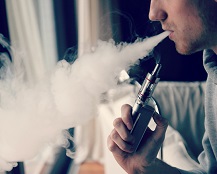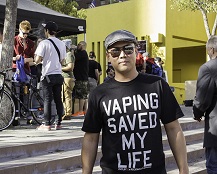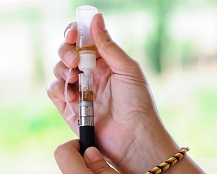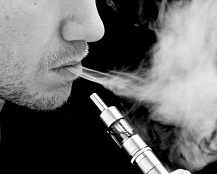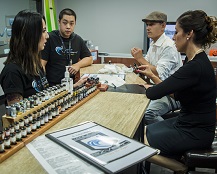The picture frequently painted for the public is that nicotine alone creates the addiction to smoking, and that nicotine in itself – whether consumed by smoking or vaping – is hugely addictive. But is this really true? Here's everything you need to know about e-cigarettes and nicotine addiction.
A new study takes aim at flavoring mixtures used for DIY e-liquid mixing, finding that some concentrated flavors contain nicotine. However, with only an uninformative extract available, the details about what they found are fuzzy. We take a look at the full paper, which shows that only two flavor concentrates out of 30 contained quantifiable levels of nicotine.
An underlying distrust of anything resembling smoking leads some of those in tobacco control to claim that we don’t even need e-cigarettes, and to look for any reason to cast doubt on the value of vaping. But the reason we really do need vaping becomes obvious as soon as you consider things from the perspective of a smoker.
A new study looking at the effect of e-cigarette vapor on human airway cells has found no sign of toxicity, with the vapor-exposed cells faring about as well as the air-exposed ones. The new finding adds further evidence that the risks associated with vaping are likely to be very small, and almost certainly much less than the risks of smoking.
A new study aims to further the anti-vaping agenda by combining two of the sources of the most indignation about the technology: advertising and the children. Stanton Glantz called the study “direct evidence that e-cig TV ads are recruiting kids to nicotine addiction,” but, as with most things that come out of his mouth, this is pretty much complete nonsense.
The worst thing about the continuous spread of misleading information and the manufacturing of misguided panics about vaping is the fact that e-cigarettes are really about harm reduction. Arguments like “e-cigarettes aren’t absolutely safe” are ridiculous in the context of harm reduction, and this becomes pretty clear when you apply common anti-vaping arguments to other forms of harm reduction.
For the just-switching smoker aiming to replace their combusted tobacco habit, navigating the veritable maze of e-liquid in search of a pleasant, tobacco-infused flavor can be a challenge. So what are the major types of tobacco e-liquid? Which tastes the best? Here’s a brief run-down of the options.
For smokers just switching to vaping, one of the most common questions is: “which e-liquid will taste like my favorite brand of cigarettes?” However, you quickly learn that finding an e-liquid that tastes like Marlboro cigarettes, for example, is not an easy task. So, do you keep searching for the e-liquid that will manage to perfectly replicate your chosen brand of cigarettes, or is there another way?
Naturally-extracted tobacco (NET) e-liquid is widely-recommended by those searching for the most realistic tobacco e-liquids, but results from e-liquid chemical and toxicological studies would suggest that they carry slightly greater risks than your average e-liquid. But is the added risk worthwhile? We take a look at the pros and cons of NET e-liquids.
The California Department of Public Health’s Still Blowing Smoke campaign and the CDC’s tips campaign are just two of the latest examples of why tobacco harm reduction is so widely misunderstood by the public. But why is the anti-science, chemo-phobic propaganda winning the PR war over e-cigarettes?
New data from ASH UK has shown that – much like in the US – the false belief that e-cigarettes are as dangerous as or more dangerous than smoking is becoming more common in both smokers and the general population. The implication is depressingly clear: frequent misleading statements about e-cigarettes are discouraging smokers from switching to the reduced harm alternative.
There are several factors that collectively shape the lifespan of your atomizer coil. The acidity level and the PG/VG consistency of your e-liquid both play an important role. Additionally, the amount you vape and the amount of power running to the coil are also contributing factors. Taking these factors into account, you can estimate how long a coil will last.
A new study from Dr. Konstantinos Farsalinos has offered confirmation that previous formaldehyde scares were due to “dry puffs,” and that with more capable atomizers (even at high powers), the levels generated are vastly lower than from cigarettes. The study shows that vapers can easily identify dry puffs, and it's only in these conditions that cigarette-like levels of aldehydes are created.
A new study from Dr. Konstantinos Farsalinos looking at existing evidence on the metal emissions from e-cigarettes has determined that vapers don’t need to be concerned about metal exposure. Vapers’ exposure to chromium, cadmium, copper, nickel, lead and cadmium was found to be between 2.6 and 37.4 times lower than the maximum allowable levels in inhalable medicines.
Little powerhouse variable voltage/variable wattage (VV/VW) box mods have been taking the vaping industry by storm recently, offering substantial power, sub-ohm capability and huge capacity batteries in portable, user-friendly packages. However, with iSticks, iPVs, XPros, Sigeleis, eGrips, MVPs and countless others to choose from, how do you go about deciding which mod to purchase?
The CDC has released the next set of National Youth Tobacco Survey data, and despite spending the last few years continually harping on about the rising use of e-cigarette by youth and its potential as a gateway to smoking, the “concern” is growing less and less believable, as the data strongly suggests that e-cigarettes are actually causing dramatic declines in youth smoking.
A new study has investigated the flavoring chemicals in e-liquids, and has generated some concern in the media about their risks, with Time using the headline “E-cigarette flavors may be dangerous, study says.” But is this another example of overstating a minor risk for the purpose of spreading mistrust of e-cigs, or is there actually something to it?
A new study has offered further evidence of the harm reduction potential of e-cigarettes, finding that e-cig vapor is less toxic to lung cells than cigarette smoke, and that it also produces less oxidative stress.
Need to write an innuendo-laden, scientific-sounding piece of scaremongering bullshit good enough to make an ex-smoking vaper decide to toss away the safer alternative and pick up a pack of comfortingly-deadly traditional cigarettes? Never fear: we have you covered.
A new study looking at one-year quit-rates for smokers purchasing their first e-cigarette has found that around 41 percent quit smoking entirely and another 25 percent reduced their cigarette consumption by at least half. The finding contradicts claims that there is no evidence e-cigarettes help you quit smoking, and joins other research in suggesting that quit-rates with e-cigs dwarf those obtained with over-the-counter NRT.



